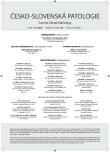Hypoglycemia in a solitary fibrous tumor of the liver
Authors:
Jirka Mačák 1; Petr Buzrla 1; Jana Dvořáčková 1; Petr Prokop 2,3; František Jalůvka 3
Authors‘ workplace:
Ústav patologie Lékařské fakulty Ostravské univerzity v Ostravě a Fakultní nemocnice Ostrava
1; Katedra chirurgických oborů Lékařské fakulty Ostravské univerzity v Ostravě
2; Chirurgická klinika Fakultní nemocnice Ostrava
3
Published in:
Čes.-slov. Patol., 52, 2016, No. 1, p. 41-44
Category:
Original Article
Overview
A 64-year-old patient developed sudden hypoglycemia leading to unconsciousness. Hypoglycemic episodes recurred on several occasions but were not accompanied by unconsciousness. Magnetic resonance imaging revealed a liver tumor in the right lobe sized 20.0 × 14.6 × 19.0 cm. No other masses were detected. Right hemihepatectomy was indicated but could not be performed due to heavy bleeding near the tumor. Histological examination showed a relatively cellular tumor made of elongated bland cells. The mitotic index was fewer than 4 mitoses per 10 HPF. The tumor was without necrosis or hemorrhage. The excised tumor was not encapsulated and showed no signs of invasive growth. On immunohistological examination, the tumor expressed NSE, CD34, CD99, Bcl2 and STAT6; Ki-67 was positive in approximately 20% of the cells. Both the histological pattern and immunophenotype were suggestive of solitary fibrous tumor of the liver. Given its size, cellularity and relatively high expression of the proliferation marker Ki-67, the tumor was classified as potentially malignant. The patient underwent embolization of arteries supplying the tumor with blood. The effect of the procedure on the tumor will only be assessed later. Hypoglycemia has resolved and the patient feels well.
Keywords:
solitary fibrous tumor – liver – hypoglycemia – immunohistology
Sources
1. Liu Q, Liu J, Chen W, Mao S, Guo Y. Primary solitary fibrous tumors of liver: a case report and literature review. Diagn Pathol 2013; 8, doi: 10.1186/1746-1596-8-195.
2. Klemperer P, Rabin CB. Primary neoplasia of the pleura. A report of five cases. Am J Ind Med 1992; 22: 1-31.
3. Singh RK, Thangakunan B, Isaac BT, Gupta A. Disseminated solitary fibrous tumour of the lung and pleura. BMJ Case Rep 2013, doi: 10.11136/bcr-2013-009362.
4. Miettinen M. Modern soft tissue pathology. Tumors and non-neoplastic conditions. Cambridge university Press: New York 2010.
5. Debs T, Kassir R, Amor IB, Martin F, Iannelli A, Gugenheim J. Solitary fibrous tumor of the liver: report of two cases and review of the literature. Int J Surg 2014; 12: 1291-1294.
6. Vernerová E, Bělina F, Hrabal P. Solitární fibrózní tumor jater. Čes a Slov Gastroent a Hepatol 2007; 61: 135-138.
7. Mohammedi K, Abi KC, Oliver S, Benabad I, Roussel R, Marre M. Paraneoplastic hypoglycemia in a patient with a malignant solitary fibrous tumor. Endocrinol Diabetes Metab Case Rep 2014, doi: 10.1530/EDM-14-0026.
8. Famà F, Yves Le B, Barrande G, Villenneuve A, Berry MG, Pidoto RR, Saint MO. Solitary fibrous tumour of the liver with IGF-II-related hypoglycaemia: a case report. Langenbecks Arch Surg 2008; 393: 611-616.
9. Penel N, Amela EY, Decanter G, Robin YM, Marec-Berard P. Solitary fibrous tumors and so-called hemangiopericytoma. Sarcoma 2012, doi: org/10.1155/2012/690251.
10. Jakob M, Schneider M, Hoeller I, Laffer U, Kaderli R. Malignant solitary fibrous tumor involving the liver. World J Gastroenterol 2013; 19: 3354-3357.
11. Bokshan SL, Doyle M, Becker N, Nalbantoglu I, Chapman WC. Hepatic hemangiopericytoma/ solitary fibrous tumor: a review of our current understanding and case study. J Gastrointest Surg 2012; 16: 2170-2176.
12. Yoshida A, Tsuta K, Ohno M, et al. STAT6 immunohistochemistry is helpful in the diagnosis of solitary fibrous tumors. Am J Surg Pathol 2014; 38: 552-559.
13. Schweizer L, Koelsche C, Sahm F, et al. Meningeal haemangiopericytoma and solitary fibrous tumors carry the NAB2-STAT6 fusion and can be diagnosed by nuclear expression of STAT6 protein. Acta Neuropathol 2013; 125: 651-658.
14. Fryer E, Chetty R. Unusual and rare tumours of the liver. Diagn Histopathol 2012; 8: 449-456.
15. Fletcher CDM, Bridge JA, Hogendoorn PCW, Mertens F. WHO classification of tumours of soft tissue and bone. IARC Press: Lyon 2013.
16. Bodnar TW, Acevedo MJ, Pietropaulo M. Management of non-islet-cell tumor hypoglycemia: a clinical review. J Clin Endocrinol Metab 2014; 99: 713-722.
17. Chaberlain MH, Taggart DP. Solitary fibrous tumor associated with hypoglycemia: an example of the Doege-Potter syndrome. J Thorac Cardiovasc Surg 2000; 11: 185-187.
18. Fukasawa Y, Takada A, Tateno M et al. Solitary fibrous tumor of the pleura causing recurrent hypoglycemia by secretion of insulin-like growth factor II. Pathol Int 1998; 48: 47-52.
19. deGroot JW, Rikhof B, vanDoorn J et al. Non-islet cell tumor-induced hypoglycaemia: a review of the literature including two new cases. Endocr Relat Cancer 2007; 14: 979-993.
20. Gordon P, Hendriks CM, Kahn CR, Megyesi K, Roth J. Hypoglycemia associated with non-islet-tumor and insulin-like growth factors: a study of the tumor types. N Engl J Med 1981; 305: 1452-1455.
21. Pink D, Schoeler D, Lindner T et al. Severe hypoglycemia caused by paraneoplastic production of IGF-II in patients with advanced gastrointestinal stromal tumors: a report of two cases. J Clin Oncol 2005; 23: 6809-6811.
22. Khowaja A, Johanson-Rabbett B, Bantle J, Moheet A. Hypoglycemia mediated by paraneoplastic production of insulin like growth factor-2 from a malignant renal solitary fibrous tumor – clinical case and literature review. BMC Endocr Disord 2014; 14: 14-49.
23. Daughaday WH, Trivedi B, Kapadia M. Measurement of insulin-like growth factor II by specific radioreceptor assay in serum of normal individuals, patients with abnormal growth hormone secretion, and patients with tumor-associated hypoglycemia. J Clin Endocrinol Metab 1981; 53: 289-294.
24. Kalebi AY, Hale MJ, Wong ML, Hoffman T, Murray J. Surgically cured hypoglycemia secondary to pleural solitary fibrous tumour: case report and update review on the Doege-Potter syndrome. J Cardiothoracic Surg 2009, doi: 10.1186/1749-8090-4-45.
Labels
Anatomical pathology Forensic medical examiner ToxicologyArticle was published in
Czecho-Slovak Pathology

2016 Issue 1
Most read in this issue
- Serrated adenomas and carcinomas of the colon
- Morphology of the gastroesophageal reflux disease
- Follicular and mantle cell lymphoma diagnosed in biopsies of gastroenterocolic region
- Skin cell response after jellyfish sting
